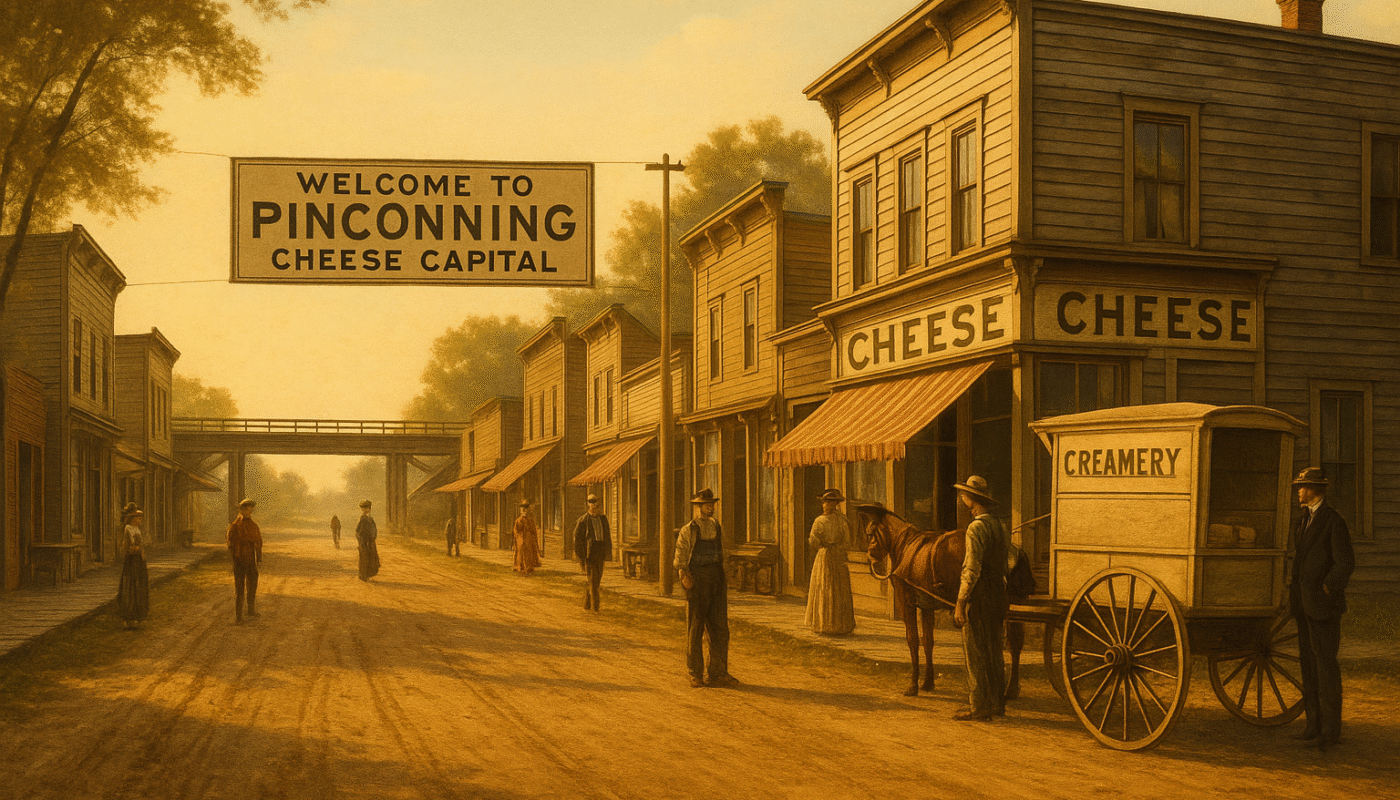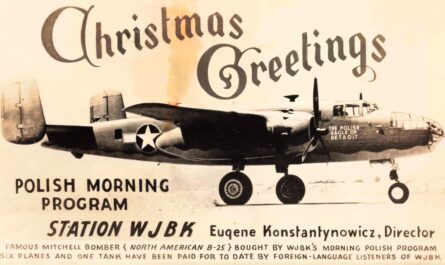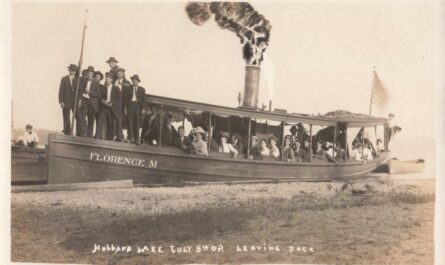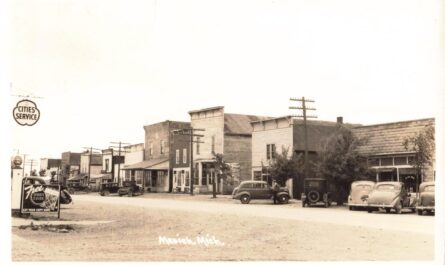When it comes to small towns with big stories, few compare to Pinconning, Michigan. Long before it was known for sharp Colby wheels and roadside cheese shops, Pinconning was a rough-edged lumber camp carved out of Bay County’s dense timber. From its earliest days along the Pinconning River in the 1870s to its rise as the “Cheese Capital of Michigan” by mid-century, Pinconning Michigan history reflects the industrial grit, rural ingenuity, and evolving identity of small-town America. This article traces the town’s journey—from log trains and stave mills to dairy barns and pickle plants.
Table of Contents
Video – Pinconning: From Pine to Cheese
Lumber Town Origins (1870s)
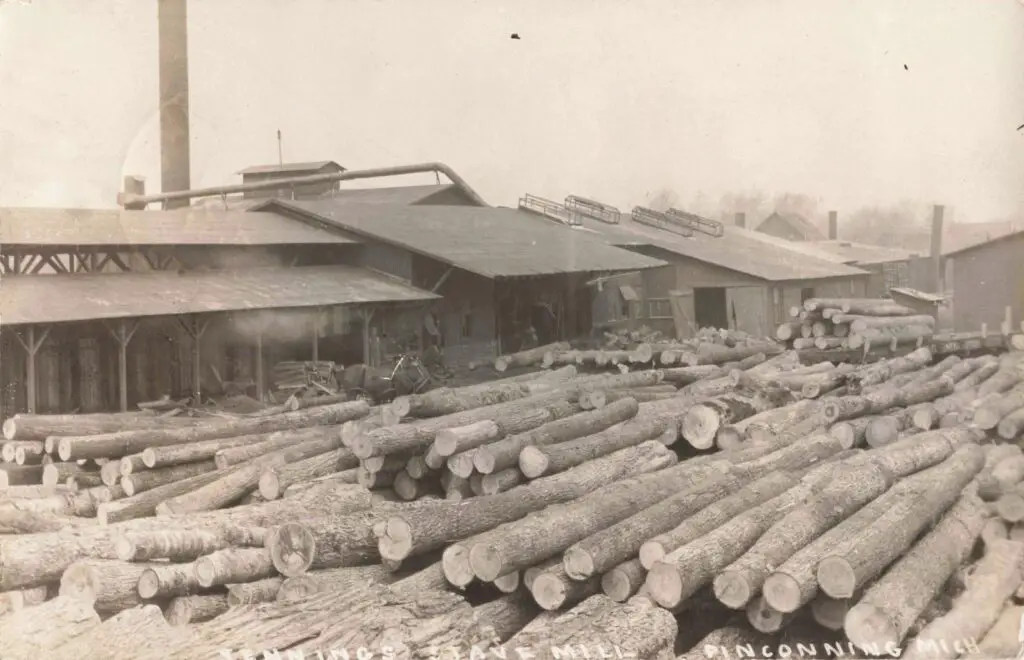
The town of Pinconning traces its roots to 1872, when lumbermen George Van Etten and Frederick “Henry” Kaiser established a logging camp and sawmill along the Pinconning River.
They chose the site for its vast stands of white pine, cedar, oak and other timber, as well as abundant wildlife, fish, and even wild potatoes in the area. (In fact, the name “Pinconning” comes from a local Chippewa word O-pin-nic-con-ing, meaning “potato place” or “place where wild potatoes grow”.) Van Etten and Kaiser’s firm built a company general store and laid out a 100-acre village plat by 1873, even securing a post office for the nascent settlement. This bold venture came on the heels of devastating forest fires in 1871 that had scorched nearby pinelands, yet the founders pressed on with their lumber enterprise.
One of Pinconning’s early claims to fame was Michigan’s first logging railroad. In 1873, Van Etten and Kaiser constructed the Pinconning & Kaiserville Railroad – an 11-mile private line that connected their Pinconning sawmill to a remote logging outpost called Kaiserville in the west. Built on the cheap “tram road” principle, the railroad’s ties were made of heavy timber with maple wood rails, yet locomotives still managed to haul loaded flatcars at up to 10–20 miles per hour.
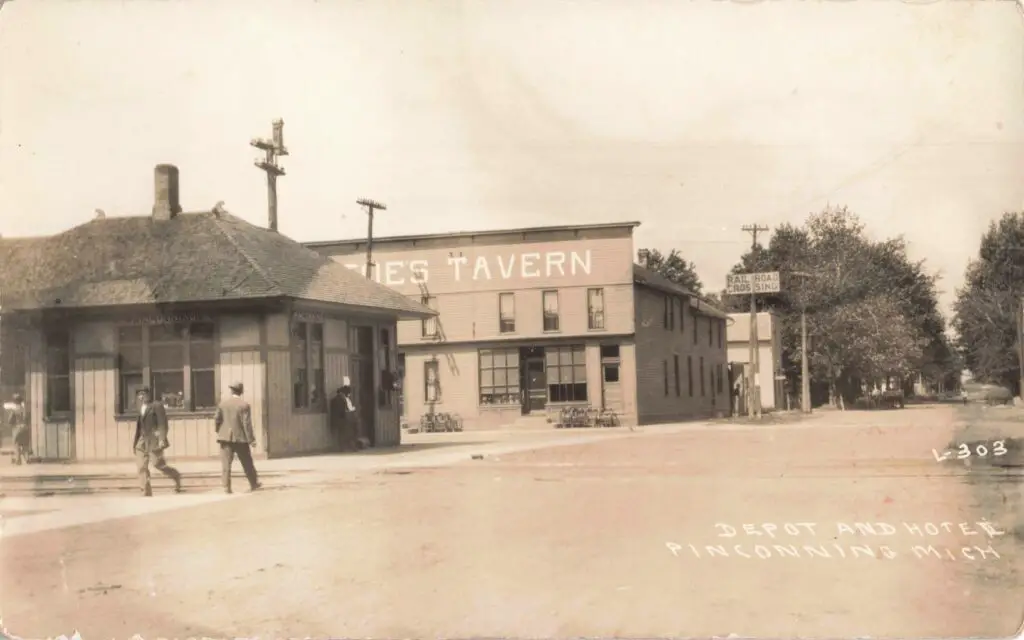
By 1875 the line was extended east to Saginaw Bay, allowing lumber to be shipped out by boat. For a time the little wood-railed railway was Pinconning’s lifeline – there were no real roads to speak of (the first paved road to town wouldn’t arrive until 1920). The rail line changed hands and names several times (becoming the Glencoe, Pinconning & Lake Shore Railroad, then Pinconning Railroad, etc.) before the Michigan Central RR purchased it in 1883.
Pinconning prospered in the late 1870s as millions of feet of timber were hauled out, but as the surrounding pine forests became depleted in the 1880s the lumber boom faded. Van Etten and Kaiser had also established a second sawmill at Kaiserville and amassed 16,000 acres of timberlands, but that satellite village faded once the logs were gone. Pinconning was compelled to seek a new direction as its logging era came to a close.
A Small Village Takes Root (1880s–1900s)
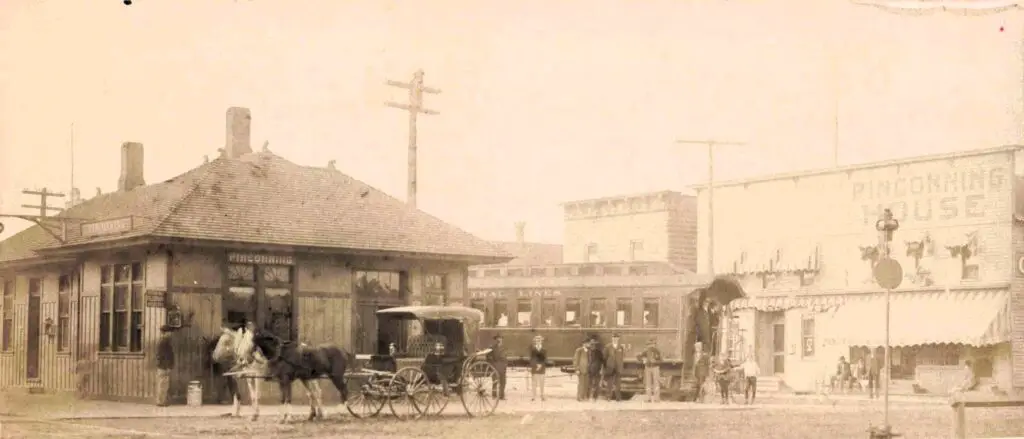
Despite the end of the big timber days, the community of Pinconning had firmly planted itself. Kaiser and Van Etten formally platted the village in 1873, and it was incorporated as an official village in 1887 (with a re-incorporation under state law in 1891). By 1900, Pinconning’s population was 729 residents – a modest but stable town in northern Bay County. Early residents built institutions that marked a growing town: a brickyard was opened and a brick schoolhouse erected (though a fire tragically destroyed the school in 1904).
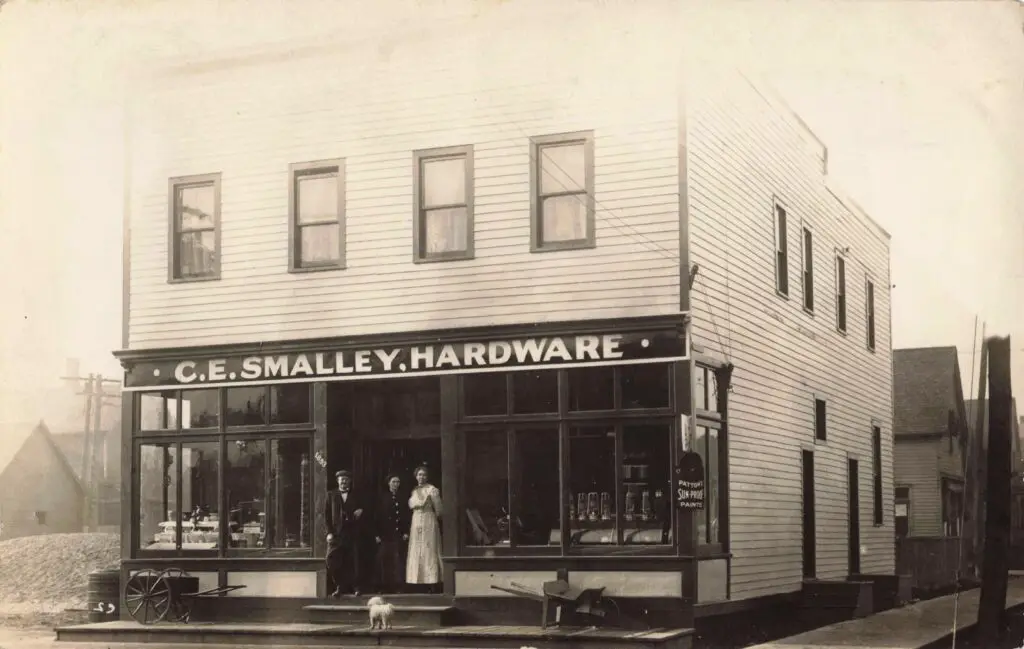
Local commerce got underway with a pioneer general store run by C.H. Rhodes and others, and the Pinconning Press newspaper began publishing by 1893. Notably, the first church in the area was actually an Indian mission established at the mouth of the Pinconning River – a reminder of the Native American presence and influence in the region. By the turn of the century, Pinconning had a rudimentary downtown and civic life, but it needed a new economic engine after lumbering.
From Timber to Dairy Farming
As the cut-over forests were converted to farms, dairy farming emerged as the next chapter for Pinconning. The sandy, wet flats along Saginaw Bay turned out to be suitable for pasture, and by the early 1900s farmers in the Pinconning area were raising cows – soon producing more milk than local markets could consume.
In 1907 a man named William Reid arrived from Ohio and established the Pinconning Creamery, the town’s first dairy processing plant. Reid’s creamery encouraged local agrarian families to invest in dairy, providing a ready outlet for their milk. By 1911, Reid’s operation had expanded and some historians later credited him with setting the foundation for Pinconning’s future identity as a cheese-making center. It was, however, a subsequent newcomer who truly put Pinconning on the map – in a very cheesy way.
Industry Expands
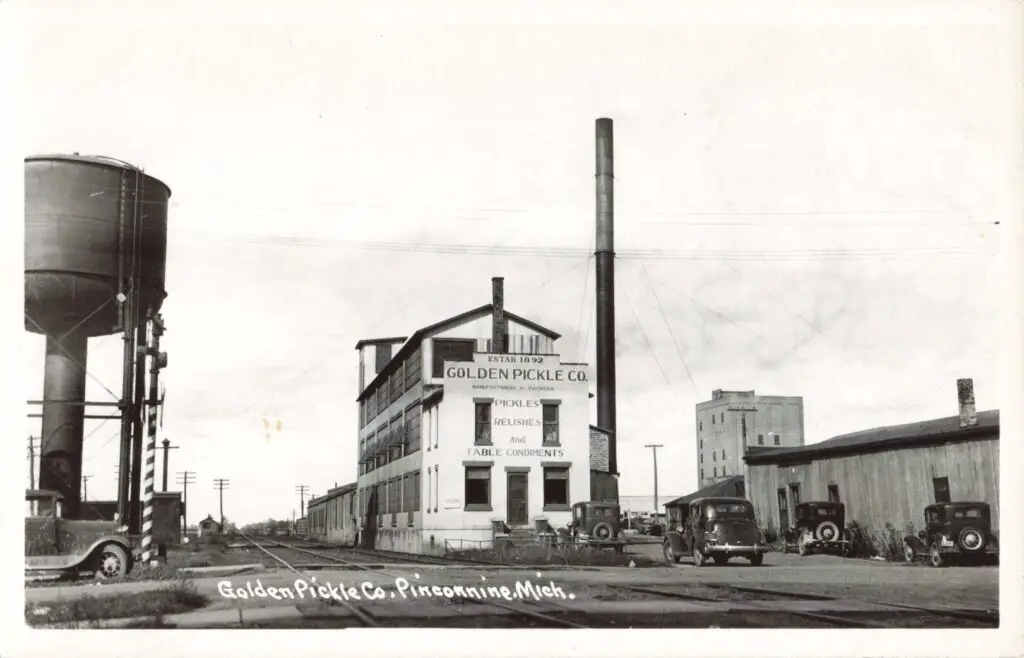
Cheese wasn’t the only thing packing crates in Pinconning. The Golden Pickle Company, founded in 1892, produced jars of pickles, relishes, and condiments from local farms. Nearby, the Chickery Factory helped to make a subsitute for coffee a reality and a little profit. These small industries kept families employed through the Great Depression and beyond.
Hazel Beach and Early Tourism
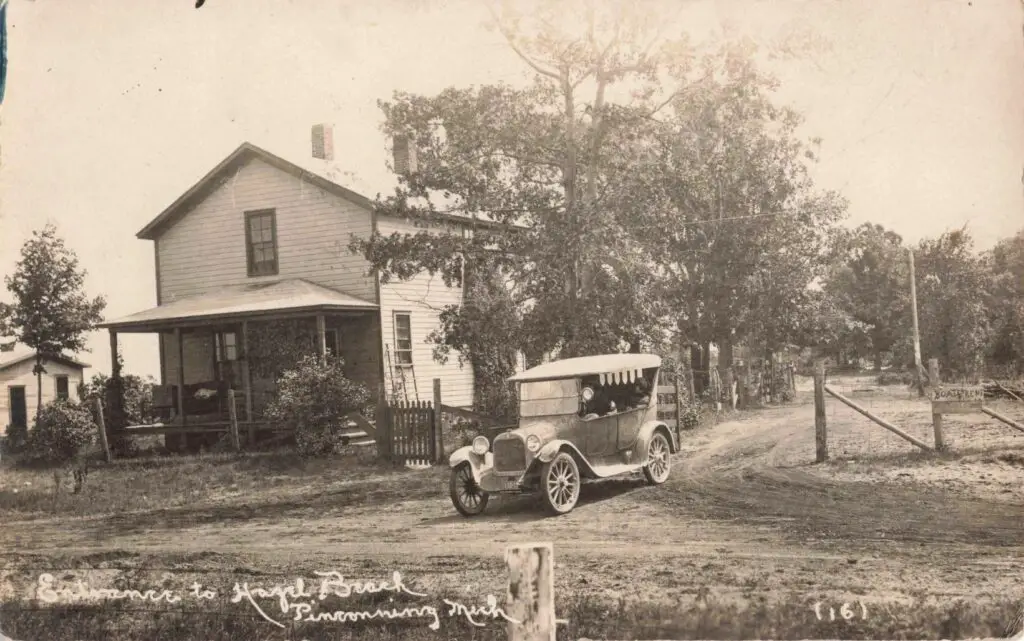
Not far from town, Hazel Beach became a favorite warm-weather escape. Early postcards show tin-roofed cottages, boat rentals, and families lounging on porches. Detroiters and Flint families made the trip north on U.S. 23, stopping in Pinconning for cheese—and a break from the city.
The Creation of Pinconning Cheese (1915)
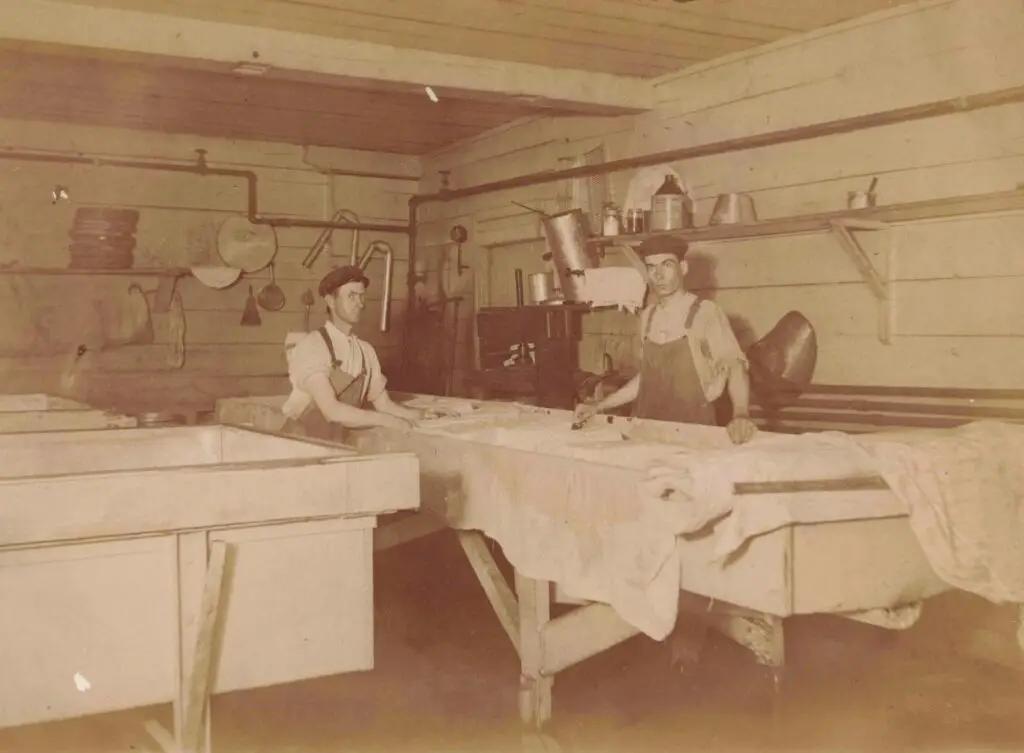
In 1915, Daniel “Dan” Horn, a European immigrant and veteran Wisconsin cheesemaker, moved to Pinconning in search of opportunity. Horn (identified in different accounts as of German or Russian origin) immediately saw potential in the surplus of local milk. He had years earlier developed a special Colby-style cheese recipe – Colby being a milder cousin of Cheddar invented in Wisconsin. Horn’s unique twist on Colby did not require strict refrigeration, since it could age at slightly warmer temperatures (important in an era when iceboxes and root cellars were the only cooling methods).
A New Twist on Colby
As it aged, this semi-hard cheese also grew sharper in flavor than ordinary young Colby. Horn set up a small cheese factory in Pinconning during the World War I years and began turning out wheels of this robust cheese. He sold “Pinconning cheese” locally at first – including at his own Horn’s Grocery on the old U.S. 23 highway – and the product quickly became a hit with Michiganders. By creatively solving the oversupply-of-milk problem, Dan Horn had given Pinconning a new identity.
Other entrepreneurs soon followed Horn’s lead in what became a full-fledged cheese industry in Pinconning. Among them was Swiss-born Paul Hitz, who brought Old World cheesemaking skills, and local farmer Joe Turmell – both started cheese factories of their own in the 1920.
Arrival of Kraft Foods

In 1936, even Kraft Foods decided to invest in Pinconning’s dairy boom: Kraft acquired the old Halpin Creamery in town and ran a cheese plant there (one that would operate for decades under Kraft’s name). At the industry’s height, as many as five cheese factories were operating in the Pinconning area simultaneously.
The once sleepy lumber village had reinvented itself as a cheese-producing powerhouse. Local farmers benefited from steady demand for milk, and “Pinconning cheese” – a rich, aged golden Colby – earned statewide fame. During the 1930s and 1940s, Pinconning’s cheese businesses prospered (even through the Great Depression and World War II) as Americans relied on cheese as an affordable, hearty food. The Pinconning product, in particular, had established itself as a best-seller across Michigan, to the point where it was even drawing tourists to the town where it was made.
Rise of the “Cheese Capital” (1940s–1950s)
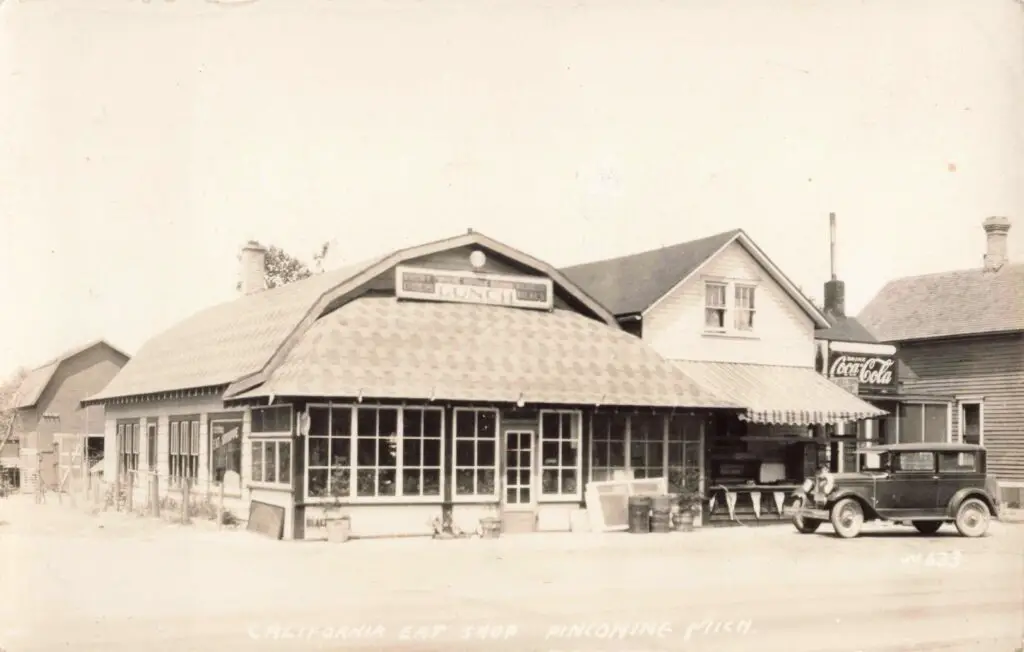
By mid-century, Pinconning was proudly known as the “Cheese Capital of Michigan.” This moniker was initially a self-proclaimed title, but it rang true – and was later officially recognized by the state, thanks to local boosters. Travelers driving Up North found it hard to resist stopping in Pinconning to sample its famous cheese. In the pre-interstate days, U.S. 23 was the main route up the Lake Huron coast, and Pinconning lay right along it. Especially during hunting and fishing season, streams of cars from Detroit and Flint would pause in Pinconning so their passengers could pick up some aged Pinconning cheese for the trip or the cabin.
Entrepreneurial families opened roadside shops to cater to this trade. One of the most iconic was Wilson’s Cheese Shoppe, which opened in 1939 when Horn’s eldest daughter Inez Horn Wilson decided to start selling her father’s cheese directly to passing tourists. Wilson’s Cheese Shoppe – today the oldest cheese store in Michigan – began as a humble retail outlet across from Dan Horn’s factory, but under Inez Wilson’s energetic leadership it grew into a cheese lover’s destination.
The Story of the Mouse
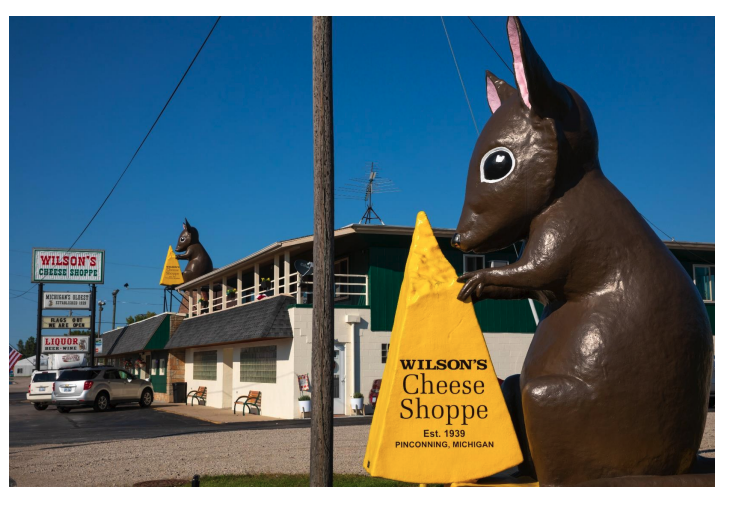
Wilson’s Cheese Shoppe as it expanded by the early 1960s, complete with a giant mouse statue on the roof – a whimsical symbol of Pinconning’s cheese fame. During the late 1950s, Inez Wilson truly put Pinconning on the map with creative marketing. She tirelessly promoted the town’s dairy delicacy – advertising Pinconning cheese on the radio, erecting billboards up and down the highway, and even snagging celebrity endorsements for their “cheese capital”. Most famously, Inez commissioned two giant fiberglass mouse mascots in 1965, mounting one big mouse (holding a piece of cheese) on the roof of Wilson’s store and another by the road, to instantly grab the attention of passing motorists.
These humorous landmark mice became beloved symbols of Pinconning. By the end of the 1950s, thanks in large part to Inez’s efforts, tens of thousands of visitors were detouring into Pinconning each year to buy cheese and snap photos with the big cheese-eating mouse. The City of Pinconning embraced its role, officially dubbing itself the “Cheese Capital of Michigan” – a title it wears proudly to this day.
The cheese trade remained strong through the 1940s and ’50s, though by around 1960 local milk production was declining as small family farms began to disappear. The cheesemakers adapted by sourcing milk from outside the immediate area, and the Pinconning brand continued to flourish. What had begun as a lumber camp in the wilderness had transformed into a uniquely flavored piece of Michigan’s cultural heritage.
Notable Personalities and Local Legends
Pinconning’s history is peppered with colorful individuals who left a lasting impact. The town’s very founders are remembered in its geography – Van Etten Street and Kaiser Street downtown bear the names of George Van Etten and Frederick A. “Henry” Kaiser, the lumbermen who started it all.
Decades later, another Pinconning native would gain fame on the national stage: Arthur E. Summerfield, born in Pinconning in 1899, who rose to serve as the 57th U.S. Postmaster General under President Dwight Eisenhower. Summerfield had moved away as a child, but his roots ran deep – his father, William Summerfield, had been Pinconning’s very first rural mail carrier around the turn of the century. In a fitting trajectory, the mail carrier’s son modernized the nation’s postal system.
Back home, one of Summerfield’s contemporaries, Russell J. Schafer, earned the nickname “Mr. Pinconning.” Schafer was a local businessman (owner of a major Chevrolet dealership) and a tireless civic leader who served 19 years on the city council and seven years as mayor mid-century. He championed local improvements and even played a role in establishing nearby Delta College in the 1950s. Under leaders like Schafer, Pinconning incorporated as a city in 1955 and continued to modernize its infrastructure.
I-75’s Impact on Pinconning
By 1960, Pinconning was a small city with an outsized personality – a place where giant mice beckoned from cheese shop rooftops and where the smell of curing cheddar had long since replaced the smell of fresh-cut pine. The opening of Interstate 75 in the mid-1960s would eventually siphon off some pass-through traffic from U.S. 23, but Pinconning’s allure did not fade.
Cheesetown Festival
To this day, the community celebrates its heritage each summer with the CheeseTown Festival, and generations of travelers have made a point to swing through “the Cheese Capital” for a hunk of Pinconning cheese and a snapshot with its famous mouse. In the span of less than a century (1872 to 1960), Pinconning’s story evolved from lumberjacks and log trains to milk cows and cheese wheels – an only-in-Michigan tale of resilience, resourcefulness, and yes, richness (in flavor, if not in fortune). And that historical journey provides ample material for any Michigan Moments episode looking to share the legacy of this unique little town.
Final Thoughts About Pinconning Michigan History

The story of Pinconning Michigan history is one of transformation, rooted in the demands of survival and driven by the promise of opportunity. What began as a rail-linked lumber village grew into a thriving agricultural hub and a statewide destination for cheese lovers. Through industry shifts, changing economies, and evolving identities, Pinconning carved its place in Michigan’s story not through size, but through character. Today, its past remains proudly visible—preserved in cheese shops, railroad relics, and the quiet shores of Hazel Beach.
Sources
- City of Pinconning (Official Site)
City of Pinconning. “History of the City.” City of Pinconning, . Accessed 21 May 2025.
City of Pinconning. “Inez Wilson: A Michigan Cheese Pioneer.” City of Pinconning, 30 Dec. 2018, . Accessed 21 May 2025.
City of Pinconning. “85 Years of Wilson’s Cheese Shoppe.” City of Pinconning, 2 July 2024, https://cityofpinconning.org/2024/07/wilsons-cheese-shoppe-celebrates-85-years-in-business/. Accessed 21 May 2025. - UpNorthTripod (Independent Michigan History Site)
“Pinconning, Michigan – Bay County’s Cheese Capital.” UpNorthTripod, http://upnorth.tripod.com/pinconning.html. Accessed 21 May 2025.
“Pinconning Railroad History.” UpNorthTripod, http://upnorth.tripod.com/pinrail.html. Accessed 21 May 2025. - Second Wave Media
Rentschler, Mark. “Pinconning’s Cheese Heritage Still Strong After More Than 100 Years.” Second Wave Media, 14 Oct. 2021, https://www.secondwavemedia.com/baycity/features/Pinconning-Cheese.aspx. Accessed 21 May 2025. - Gander Newsroom (Michigan News Analysis)
Becker, Kyle. “Meet the Woman Who Made Pinconning the Cheese Capital of Michigan.” Gander Newsroom, 9 Aug. 2022, https://gandernewsroom.com/2022/08/09/pinconning-cheese-michigan/. Accessed 21 May 2025. - Michigan Railroads (Rail Infrastructure History)
“Pinconning, MI.” MichiganRailroads.com, https://www.michiganrailroads.com/stations-locations/73-bay-county-09/500-pinconning-mi. Accessed 21 May 2025. - University of Michigan Library – David V. Tinder Collection
University of Michigan Library. “Entrance to Hazel Beach, Pinconning, Mich.” David V. Tinder Collection of Michigan Photography, William L. Clements Library, https://quod.lib.umich.edu/t/tinder/x-4448/tinder-rppc-008896. Accessed 21 May 2025.
(Other historical postcards and real photo images featured in the narrative are from the Tinder RPPC collection hosted at the University of Michigan Library Digital Collections.) - Pinconning Cheese Company
“Old-Fashioned Pinconning Cheese.” Pinconning Cheese Company, https://pinconningcheese.com/product-category/cheese/old-fashioned-pinconning-cheese/. Accessed 21 May 2025.
